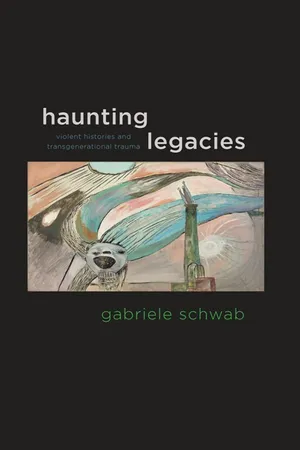![]()
Notes
1. Introduction
1. See Diana Fuss, Identification Papers (New York: Routledge Press, 1995), 1–19.
2. Ruth Kluger, Still Alive: A Holocaust Girlhood Remembered (New York: The Feminist Press, 2001), 80.
3. Ishmael Beah, A Long Way Gone: Memoirs of a Boy Soldier (New York: Farrar, Straus and Giroux, 2008), 52.
4. See W. R. Bion, “Attacks on Linking,” in Second Thoughts: Selected Papers on Psychoanalysis (1967; London: Karnac, 2005), 93–109. See also Mary Jacobus, “The Pain in the Patient’s Knee,” Diacritics 28, no. 4 (1998): 99–110.
5. Beah, A Long Way Gone, 103.
6. I need to emphasize that my specific reflections on postwar Germany draw exclusively on my own experiences of growing up in West Germany under French occupation. The difference between dealing with the legacies of the Holocaust in West and East Germany, then under Russian occupation, are enormous and cannot be treated here. They would have to be the object of a different comparative study. I am grateful for many discussions with Claudia Sadowski-Smith and hope for a future collaboration on this topic.
7. Jacques Derrida, “Fors,” trans. Barbara Johnson, Georgia Review 31 (1977): 75.
8. Ibid., 78.
9. Ibid., 99.
10. Sabine Reichel, What Did You Do in the War, Daddy? (New York: Hill and Wang, 1989), 9.
11. See Wendy Brown, States of Injury: Power and Freedom in Late Modernity (Princeton, N.J.: Princeton University Press, 1995); Lauren Berlant, “The Face of America and the State of Emergency,” in Popular Culture: A Reader, ed. Raiford Guins and Omayra Zaragoza Cruz (London: Sage Press, 2005), 309–23; and Mark Seltzer, “Wound Culture: Trauma in the Pathological Public Sphere,” October 80 (Spring 1997): 3–26.
12. Shoshana Felman and Dori Laub, Testimony: Crises of Witnessing in Literature, Psychoanalysis, and History (New York: Routledge Press, 1992), xx.
13. I use the concept of “unthought knowledge” as developed by Christopher Bollas in The Shadow of the Object: Psychoanalysis of the Unthought Known (New York: Columbia University Press, 1988). The term is further elaborated for literary and art objects in my essays, “Words and Moods: The Transference of Literary Knowledge,” SubStance 26, no. 3 (1997): 107–27, and “Cultural Texts and Endopsychic Scripts,” SubStance 30, nos. 1 and 2 (2001): 160–76.
14. For further elaboration of the concept of transformational literary and artistic objects see Schwab, “Words and Moods” and “Endopsychic Scripts.”
15. See Renate Lachmann, Memory and Literature: Intertextuality in Russian Modernism, trans. Anthony Wall (Minneapolis: University of Minnesota Press, 1997), and Jan Assmann, “Kollektives Gedächtnis und kulturelle Identität,” in Kultur und Gedächtnis, ed. Jan Assmann and Tonio Hoelscher (Frankfurt: Suhrkamp, 1988), 9–19.
16. See Aleida Assmann, Erinnerungsräume: Formen und Wandlungen des kulturellen Gedächtnisses (Munich: Beck, 1999); Aleida Assmann and Ute Frevert, Geschichtsvergessenheit—Geschichtsversessenheit: Vom Umgang mit der Deutschen Vergangenheit Nach 1945 (Stuttgart: Deutsche Verlags-Anstalt 1999); Aleida Assmann, Der Lange Schatten der Vergangenheit: Erinnerungskultur und Geschichtspolitik (Munich: Beck, 2006).
17. Dominick LaCapra, “Representing the Holocaust,” in Probing the Limits of Representation: Nazism and the “Final Solution,” ed. Saul Friedlander (Cambridge, Mass.: Harvard University Press, 1992), 110.
18. Ibid., 110.
19. Ibid., 125.
20. Recent debates on the inclusion of the personal in writings about violent histories have largely focused on the “authority of experience.” The perspective of transference shifts the debate in a different and, I think, more pertinent direction. See Gayatri Chakravorty Spivak, “Terror: A Speech After 9–11,” boundary 2 31, no. 2 (2004): 81–111.
21. LaCapra, “Representing the Holocaust,” 125.
22. Ibid., 122.
23. Eric L. Santner, “History Beyond the Pleasure Principle,” in Probing the Limits of Representation: Nazism and the “Final Solution,” ed. Saul Friedlander (Cambridge: Harvard University Press, 1992), 144.
24. Ibid., 145.
25. Ibid., 150.
26. Ibid., 153.
27. Ibid., 151.
28. Alexander Mitscherlich and Margarete Mitscherlich, The Inability to Mourn: Principles of Collective Behavior, trans. Beverley R. Placzek (New York: Grove Press, 1975).
29. Karl Jaspers, The Question of German Guilt, trans. E. B. Ashton (New York: Dial Press, 1947).
30. Jürgen Habermas, “Concerning the Public Use of History,” trans. Jeremy Leaman, New German Critique, no. 44 (1988): 44.
31. Mitscherlich and Mitscherlich, The Inability to Mourn, xviii.
32. Marianne Hirsch, Family Frames: Photography, Narrative, and Post-memory (Cambridge, Mass.: Harvard University Press, 1997).
33. Ibid., 12.
34. Ibid., 13.
35. Ibid., 22.
36. Ibid., 34.
37. Naomi Mandel, Against the Unspeakable: Complicity, the Holocaust, and Slavery in America (Charlottesville: University of Virginia Press, 2006), 116.
38. Michael G. Levine, “Necessary Stains: Spiegelman’s Maus and the Bleeding of History,” American Imago 59, no. 3 (2002): 338.
39. Geoffrey Hartman, “The Longest Shadow,” in Testimony: Contemporary Writers Make the Holocaust Personal, ed. David Rosenberg (New York: Times Books, 1989), 437.
40. Shoshana Felman, The Juridical Unconscious: Trials and Traumas in the Twentieth Century (Cambridge, Mass.: Harvard University Press, 2002), 153.
41. Amy Hungerford, The Holocaust of Texts: Genocide, Literature, and Personification (Chicago: University of Chicago Press, 2003), 73–74.
42. Ibi...
